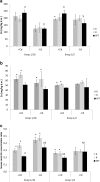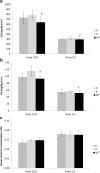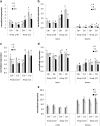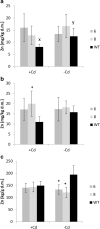Determination the Usefulness of AhHMA4p1::AhHMA4 Expression in Biofortification Strategies
- PMID: 27358503
- PMCID: PMC4877419
- DOI: 10.1007/s11270-016-2877-0
Determination the Usefulness of AhHMA4p1::AhHMA4 Expression in Biofortification Strategies
Abstract
AhHMA4 from Arabidopsis thaliana encodes Zn/Cd export protein that controls Zn/Cd translocation to shoots. The focus of this manuscript is the evaluation of AhHMA4 expression in tomato for mineral biofortification (more Zn and less Cd in shoots and fruits). Hydroponic and soil-based experiments were performed. Transgenic and wild-type plants were grown on two dilution levels of Knop's medium (1/10, 1/2) with or without Cd, to determine if mineral composition affects the pattern of root/shoot partitioning of both metals due to AhHMA4 expression. Facilitation of Zn translocation to shoots of 19-day-old transgenic tomato was noted only when plants were grown in the more diluted medium. Moreover, the expression pattern of Zn-Cd-Fe cross-homeostasis genes (LeIRT1, LeChln, LeNRAMP1) was changed in transgenics in a medium composition-dependent fashion. In plants grown in soil (with/without Cd) up to maturity, expression of AhHMA4 resulted in more efficient translocation of Zn to shoots and restriction of Cd. These results indicate the usefulness of AhHMA4 expression to improve the growth of tomato on low-Zn soil, also contaminated with Cd.
Keywords: Biofortification; Cadmium; HMA4; Tomato; Transformation; Zinc.
Figures







Similar articles
-
Approach to engineer tomato by expression of AtHMA4 to enhance Zn in the aerial parts.J Plant Physiol. 2014 Sep 15;171(15):1413-22. doi: 10.1016/j.jplph.2014.04.017. Epub 2014 Jun 12. J Plant Physiol. 2014. PMID: 25046762
-
Functional analysis of the three HMA4 copies of the metal hyperaccumulator Arabidopsis halleri.J Exp Bot. 2015 Sep;66(19):5783-95. doi: 10.1093/jxb/erv280. Epub 2015 Jun 4. J Exp Bot. 2015. PMID: 26044091 Free PMC article.
-
Metal accumulation in tobacco expressing Arabidopsis halleri metal hyperaccumulation gene depends on external supply.J Exp Bot. 2010 Jun;61(11):3057-67. doi: 10.1093/jxb/erq129. Epub 2010 May 19. J Exp Bot. 2010. PMID: 20484319 Free PMC article.
-
Metal response of transgenic tomato plants expressing P(1B) -ATPase.Physiol Plant. 2012 Jun;145(2):315-31. doi: 10.1111/j.1399-3054.2012.01584.x. Epub 2012 Mar 13. Physiol Plant. 2012. PMID: 22283486
-
Engineering high Zn in tomato shoots through expression of AtHMA4 involves tissue-specific modification of endogenous genes.BMC Genomics. 2016 Aug 12;17(1):625. doi: 10.1186/s12864-016-2990-x. BMC Genomics. 2016. PMID: 27519859 Free PMC article.
Cited by
-
Recent Trends in Enhancing the Resistance of Cultivated Plants to Heavy Metal Stress by Transgenesis and Transcriptional Programming.Mol Biotechnol. 2019 Oct;61(10):725-741. doi: 10.1007/s12033-019-00202-5. Mol Biotechnol. 2019. PMID: 31372919 Review.
References
-
- Antosiewicz DM, Escudĕ-Duran C, Wierzbowska E, Skłodowska A. Indigenous plant species with the potential for the phytoremediation of arsenic and metals contaminated soil. Water Air and Soil Pollution. 2008;193:197–210. doi: 10.1007/s11270-008-9683-2. - DOI
-
- Arruda MAZ, Azevedo RA. Metallomics and chemical speciation: towards a better understanding of metal-induced stress in plants. Annals of Applied Biology. 2009;155:301–307. doi: 10.1111/j.1744-7348.2009.00371.x. - DOI
LinkOut - more resources
Full Text Sources
Other Literature Sources
